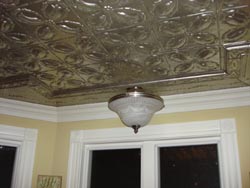What are popcorn ceilings? Most people equate popcorn with going to the movies and munching on the fluffy white stuff while sitting back and relaxing at the movie theater or at home. What does popcorn have to do with our homes?

Many home owners remember when they had a popcorn ceiling and wanted to get rid of the bumpy texture. People feel it dates a house, that it's difficult to paint and almost impossible to match texture after making repairs to the ceiling. Here is information to help you decide what to do with your popcorn ceilings.
Why Popcorn Ceilings?
Popcorn ceilings became popular in the 1950s, during the construction boom following World War 2. When builders were putting up 100s of homes, they found it faster to spray on a popcorn ceiling texture versus paint. This reduced costs by omitting the final (3rd) coat of mud. Popcorn is also good at masking uneven seams where the sheetrock meets and other defects that pop out after a ceiling is painted. Popcorn ceilings continue to be popular in warm climates where high ceilings are used to draw hot air away from the living space below.
The popcorn ceiling texture also provides some noise reduction qualities, so it's used more often for bedroom and hallway ceilings. Kitchens and living room ceilings might then have a flat or smoother texture for higher durability and ease of cleaning. Acoustic ceilings evolved into the metal grids and drop down panels we now recognize in schools, offices and businesses where they need noise reduction. Acoustic tiles remain popular for home basements where there are plumbing, heating and cooling structures to hide.
Steps to Removing Your Popcorn Ceiling
Many home owners consider removing the popcorn from their ceilings but they're not sure what's involved, and more important what it will cost.
Asbestos Precautions
If your home was built prior to 1978, you first need to test (typically $25 per sample) to see if your popcorn contains asbestos. Similar to lead, asbestos (learn more at www.epa.gov/asbestos) should be removed by qualified professionals, adding to projects costs.
Evaluate Your Ceiling Options
There are numerous ways to change your ceiling when you decide to get rid of the popcorn, and some of these don't require removing the popcorn which is good when there is asbestos (some states prohibit “hiding” asbestos materials.
- New sheetrock? If you're planning to paint the entire room, it may be more cost effective to install a new ceiling (half inch sheetrock) on top of what's there, and thus avoid removal of the popcorn texture. This works well with higher (more than 8 ft) ceilings where losing a half inch won't be noticeable. The challenge comes with open concept homes where you might have to install new sheetrock in multiple rooms and/or hallways … but you can creatively add ceiling trim to separate ceiling areas.
- Decorative ceiling tile? There are many choices for ceiling tiles from the tin ceiling shown here, to aluminum, plastic, foam, wood and mirror tiles in hundreds of colors and styles. Many of these tiles are glued up while others use a tongue and groove design similar to engineered flooring.
White Decorative Tile Antique Bronze Black
Antique Bronze Black Nail-up Tin Ceiling Tiles
Nail-up Tin Ceiling Tiles Circles & Stars Ceiling Tile
Circles & Stars Ceiling Tile
- Remove popcorn ceiling texture? Removing the popcorn will be easier if the ceiling has never been painted. The popcorn comes off more easily when you're able to saturate it with water, to start the glue letting go. When the ceiling has been painted, it will be difficult for water to reach the ceiling side of the popcorn to start this process.
If you're ready to move forward and remove your popcorn ceiling texture, plan the project out and tackle one room at a time. Review the steps to Remove a Popcorn Ceiling, to get an idea of how much time you'll need.









Leave a Reply